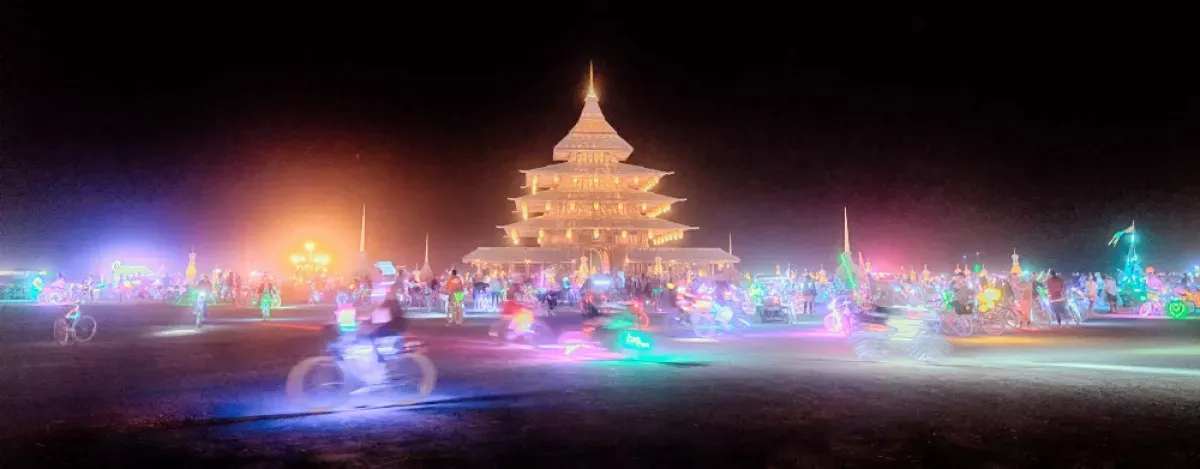Burning Man is an annual week-long event held in the Black Rock Desert of Nevada. Characterized by its principles of community, art, self-expression, and self-reliance, the event culminates in the burning of a large wooden effigy known as "the Man." Since 1991, Black Rock City, a temporary city, has been erected to host the event, emphasizing principles like gifting, decommodification, and leaving no trace.
1955: Release of "Bad Day at Black Rock"
The film "Bad Day at Black Rock" was released in 1955, later serving as inspiration for the title of "Zone Trip No. 4," a precursor to Burning Man.
1967: DMV Sets Criteria for Mutant Vehicles
The Nevada Department of Motor Vehicles (DMV) established criteria for approving "Mutant Vehicles" at Burning Man. One requirement is that the base vehicle must still be recognizable. For instance, a 1967 VW van adorned with decorations needs to retain its identifiable VW van features. Otherwise, it's classified as an "Art Car" rather than a Mutant Vehicle.
1973: The Wicker Man Film Released
"The Wicker Man," a film released in 1973, later became associated with Burning Man despite not being its inspiration, as clarified by Larry Harvey.
June 21, 1986: Construction of the First Burning Man Effigy
On June 21, 1986, the first Burning Man effigy was built by Larry Harvey and Jerry James, a symbol that would define the event.
June 22, 1986: The First Burning Man
On June 22, 1986, the inaugural Burning Man took place on Baker Beach in San Francisco. This marked the beginning of the now-iconic event.
1986: The Cacophony Society and "Zone Trips"
The Cacophony Society, influenced by Tarkovsky's film "Stalker," began in 1986 and organized "Zone Trips," shaping the early spirit of Burning Man.
1987: Burning Man Grows Taller
The Burning Man effigy grew to 15 feet in 1987, marking an early stage in its evolving scale and artistic expression.
1988: Burning Man Officially Named
Larry Harvey formally named the event "Burning Man" in 1988, distinguishing it from other traditions and solidifying its identity.
1988: Burning Man Effigy Reaches 30 Feet
The Burning Man effigy reached a height of 30 feet in 1988, demonstrating the increasing ambition and scale of the event's central symbol.
1990: Burning on the Playa Surface
From 1990 through 1999, burning was allowed directly on the surface of the playa at Burning Man, which resulted in burn scars on the playa's surface.
1990: Zone Trip No. 4 and the Birth of Black Rock City
Kevin Evans and John Law organized "Zone Trip No. 4" in 1990, a pivotal event that laid the groundwork for what would become Black Rock City.
1991: Burning Man Transitions to Black Rock Desert
Burning Man found a permanent home in the Black Rock Desert of Nevada in 1991, marking a significant turning point in its history. Prior to this, the event lacked formal organization, with attendees instinctively forming a large circle reminiscent of traditional campfire gatherings.
1991: First Legal Permit and Crimson Rose's Arrival
Burning Man obtained its first legal permit from the BLM in 1991, marking a significant milestone. That same year, Crimson Rose, later the event's first art director, attended for the first time.
1991: Burning Man Finds a Home
In 1991, Burning Man moved to its now-permanent location in Black Rock City, Nevada. This marked a pivotal moment in the event's history.
1991: The Black Rock Rangers are Formed
Michael Mikel established the Black Rock Rangers in 1991, ensuring the safety and well-being of participants in the challenging desert environment.
1992: Desert Siteworks Continues
Desert Siteworks continued its run, further influencing and being influenced by the growing Burning Man community in 1992.
1992: Electronic Music Debuts at Burning Man
Reflecting the influence of San Francisco's rave culture, camps dedicated to electronic music, often featuring live DJs, emerged at Burning Man in 1992. This marked the beginning of electronic music's integration into the event's soundscape.
1993: Desert Siteworks and Burning Man Collaboration
Desert Siteworks continued for its second and third years in 1993 and 1994, fostering collaboration and exchange of ideas with Burning Man.
1993: First Dedicated Sound Camp Opens at Burning Man
The year 1993 witnessed the emergence of the first designated sound camp at Burning Man, dubbed the "Techno Ghetto." Situated two miles north of Center Camp, this area served as a hub for electronic music enthusiasts, featuring a central gathering point, camping space, and six large sound systems. This development reflected the growing influence of electronic music on Burning Man's culture.
1994: Desert Siteworks Concludes
Desert Siteworks concluded its three-year run in 1994, leaving a lasting impact on the Burning Man community and its ethos.
1995: Pilots Begin Camping at Temporary Airport
In 1995, pilots began camping at the temporary airport set up for Burning Man. This airport is established before each event and completely erased afterward.
1996: Last Year of the Techno Ghetto
1996 marked the last year for the techno ghetto at Burning Man. Despite its end, the enthusiasm for music had already spread, leading to the formation of other sound camps.
1996: Formal Partnership and Last Year Without a Fence
In 1996, a formal partnership was established for "Burning Man." It also marked the final year the event was held without a fence, signifying a turning point in its growth and management.
1996: Tragedy and John Law's Departure
In 1996, a worker died in a motorcycle accident before the event officially began. Another accident involving an art car occurred within the event. Following these tragedies, co-founder John Law left Burning Man, publicly stating his belief that it should not continue.
1996: Introduction of Ring Road and No Man's Land
In 1996, with the population growing to 8,000, Burning Man introduced more structure to appease the Bureau of Land Management and ensure safety. Ring Road was added around Center Camp, creating a second circle of theme camps. The eastern section was declared 'No Man's Land,' devoid of art installations and campsites, to provide a clear view of the Man from Center Camp.
1997: First Ranger-Patrolled Perimeter and Entry Gate
1997 was notable for the first Ranger-patrolled perimeter and the establishment of a single entry gate at Burning Man.
1997: Burning Man Relocates to Fly Ranch
In 1997, Burning Man faced a major obstacle when its permit for Black Rock was denied due to a conflicting permit held by a land speed trials team. As a result, the event was relocated to Fly Ranch and the adjacent Hualapai dry lakebed, west of the Black Rock desert. This move brought about new jurisdictional challenges and permit requirements, ultimately leading to significant organizational changes in the years to come.
1997: Relocation and Redesign
In 1997, Burning Man was relocated to Hualapai Flat due to political issues with Washoe County. The event saw the introduction of formal streets, zoning, and vehicle registration. Rod Garret became the lead designer, forming a shallow 'V' shape around the Man with two angular arms and six annular roads.
1998: BLM Proposes Attendance Limits, Sparking Controversy
As Burning Man's popularity surged, the Bureau of Land Management (BLM) began exploring ways to manage the event's growing impact. In 1998, the BLM proposed a complex usage formula that effectively capped attendance at the previous year's level. This proposal sparked immediate controversy within the Burning Man community, who viewed it as a threat to the event's ethos of inclusivity and growth.
1998: Return to the Playa and Modern Layout
Burning Man returned to the playa in 1998, and the modern layout began to take shape. Rod Garret's design smoothed out the angular 'V' from 1997 and implemented an arc, with radial streets numbered North 1–20 and South 1–20.
1998: Burning Man Returns to Black Rock Desert
In 1998, Burning Man returned to the Black Rock desert after a one-year stint at Fly Ranch. However, instead of the deep playa, the event was held in a different area, and a temporary perimeter fence was introduced. This marked the beginning of Burning Man's long-term presence in its now-iconic location.
1999: Burning Man Gains Formal Structure
Black Rock City LLC was established in 1999, representing a significant step in formalizing the organization of Burning Man.
1999: Burning Man Adopts Concentric Street Layout
Burning Man adopted a concentric street design for its city layout in 1999. This arrangement features a series of circular streets forming an arc, encompassing two-thirds of a 1.5-mile diameter circle with the "Man" sculpture at its center. The remaining third of the circle is left open for art installations.
1999: End of Burning on the Playa Surface
By 1999, it was determined that the burn scars from burning directly on the playa surface did not dissipate with annual rains and flooding.
1999: Burning Man Names Streets After Planets
For the "Wheel of Time" theme, Burning Man named its streets after the planets of our solar system in 1999. This approach aimed to create a memorable and easily navigable layout for participants. This naming convention was used again in 2004 for the "Vault of Heaven" theme.
1999: Establishment of the Airport
In 1999, Burning Man's temporary airport was established in a form acceptable to the Bureau of Land Management through the efforts of Tiger Tiger (Lissa Shoun) and LLC board member Mr. Klean (Will Roger).
1999: Expansion of the Great Arc
In 1999, for the Wheel of Time theme, the great arc of the city was expanded to the full 240° that it is today. Streets were renumbered to correspond to a clock face, with the Man in the center and Center Camp at 6:00.
2000: Implementation of Burn Platforms
In 2000, Burning Man declared that fires must be elevated from the playa surface to protect it, implementing the use of burn platforms.
2000: Eradication of Burn Scars
In 2000, the DPW cleanup crew, led by Dan Miller, eradicated 250 burn scars discovered by Friends of Black Rock / High Rock founders and BLM Winnemucca district director Terry Reid.
2000: Introduction of the Temple
In 2000, the Temple was introduced as a major fixture at Burning Man, located at 12:00 in the deep playa. The concept of a loud side was also introduced, with large-scale sound camps placed at the 10:00 and 2:00 edges.
2002: Burning Man Experiments with Compass-Based Street Design
In 2002, Burning Man experimented with a compass-themed street layout, aligning with its "The Floating World" theme. Streets were identified using compass degrees (e.g., 175 degrees), offering a unique navigational experience.
2002: The "Trash Fence" is Erected
In 2002, a 9.2-mile-long temporary plastic fence, known as the "trash fence," was erected around the perimeter of the Burning Man event. This 4-foot-high barrier aimed to prevent wind-blown debris from escaping the campsites and impacting the surrounding environment. The implementation of the trash fence marked an increased focus on environmental responsibility and containment within the event's boundaries.
2003: Burning Man Introduces Conceptual Street Names
For its "Beyond Belief" theme in 2003, Burning Man implemented an unconventional street naming system using adjectives like "Rational" and "Absurd" for radial streets, intersecting with concentric streets named after concepts like "Authority" and "Creed." This resulted in phrases like "Absurd Authority" and "Rational Creed" at intersections, creating a thought-provoking but ultimately unpopular layout due to navigation difficulties.
2004: Burning Man Reuses Celestial Street Names
In 2004, Burning Man brought back the street names inspired by the solar system for its "Vault of Heaven" theme. This repetition of the naming convention used in 1999 for the "Wheel of Time" theme aimed to provide a familiar and easily navigable layout for attendees.
2004: The Ten Principles are Defined
In 2004, Larry Harvey, co-founder of Burning Man, formally outlined the event's ten guiding principles, solidifying its ethos and values.
2004: Burning Man Codifies Its 10 Principles
Larry Harvey, a founder of Burning Man, wrote the event's 10 Principles in 2004. Initially guidelines for regional organizers, they evolved into the universal ethos of the Burning Man movement, shaping its culture and community.
2005: Burning Man Attendee Burned in 2005 Sues
In 2005, a visitor to Burning Man sustained burns during the event and subsequently filed a lawsuit against Black Rock City LLC. The lawsuit alleged negligence on the part of the organizers.
2006: Burning Man Funds 29 Art Installations
In 2006, Burning Man's Artery department, responsible for facilitating art installations, provided grants to support the creation of 29 art pieces. These grants, totaling a significant portion of ticket sales revenue (around $500,000 in recent years), aim to assist artists in realizing ambitious projects beyond their individual means.
2006: Population Cap and Fee Structure Implemented
In 2006, the Burning Man organization and the BLM reached a significant agreement, formalizing attendance limits and establishing a fee structure based on daily population counts. This agreement, known as the Special Recreation Permit (SRP), stipulated that Burning Man manage ticket sales to cap attendance growth at 6% above the previous year's peak. Fees were calculated based on daily population counts at noon, excluding BRC staff for the first time.
2006: Carbon Footprint and Sierra Club Criticism
In 2006, the CoolingMan organization estimated that Burning Man generated 27,000 tons of carbon dioxide, primarily from transportation. In 2010, the Sierra Club criticized the festival for the plastic water bottles and flamboyant flames and explosions.
2007: Green Man Theme and Crude Awakening Criticism
Burning Man's 2007 theme, 'Green Man,' faced criticism for the Crude Awakening artwork, which used large amounts of jet fuel and liquid propane to create a massive mushroom cloud.
2007: Carbon Offset Initiatives
In 2007, to offset some of the event's carbon footprint, 30- and 50-kilowatt solar arrays were constructed, providing an estimated annual carbon offset of 559 tons. The Burn Clean Project also helped replace fossil fuels with biodiesel.
June 30, 2009: Burning Man Wins Lawsuit Over Burning Incident
On June 30, 2009, the California Court of Appeal ruled in favor of Black Rock City LLC in the lawsuit filed by the visitor who was burned at the 2005 event. The court determined that individuals who intentionally approach the burning Man effigy assume the risk of potential harm, upholding the principle of personal responsibility within the context of the event.
2009: FAA Recognition of the Private Airport
In 2009, the temporary airport at Burning Man was recognized by the FAA as a private airport, designated 88NV.
August 2010: FBI Initiates Burning Man Surveillance
In August 2010, the FBI circulated a memo to its Nevada field offices, stating its intention to have a presence at Burning Man. The agency's objective was to assist in preventing terrorist activities and collect intelligence, despite a prior threat assessment that primarily identified drug use and crowd control as concerns.
2010: Sierra Club Criticism
In 2010, the Sierra Club criticized Burning Man for the environmental impact of plastic water bottles and ostentatious flames and explosions.
2010: Burning Man Features Over 600 Mutant Vehicles
The 2010 Burning Man event showcased over six hundred registered Mutant Vehicles, highlighting their significance in the event's culture and the creativity of participants in transforming vehicles into mobile art installations.
2011: Additional Radial Streets
In 2011, extra radial streets were added from G street outwards to improve outer-city navigation. These streets were placed at fifteen-minute intervals.
2011: Fee Structure Tied to Adjusted Gross Income
In 2011, the fee structure for Burning Man underwent a notable change, shifting from a system based on daily population counts to one based on adjusted gross income. This adjustment aimed to distribute the financial burden more equitably among attendees, reflecting a commitment to accessibility and affordability.
2011: Rod Garrett, Burning Man City Designer, Passes Away
Rod Garrett, the architect who designed the grid layout for Black Rock City, passed away in 2011 at the age of 76. Garrett played a crucial role in shaping the physical infrastructure of Burning Man, ensuring the city's navigability for emergency services. He also left a lasting legacy through his designs for various Burning Man structures, including the Man bases, center camp café, and first camp.
2012: Definition of "Participant" and Population Cap Refined
The 2012 Special Recreation Permit (SRP) introduced further refinements to population management at Burning Man. The term "participant" was formally defined to encompass all attendees, including paid participants and volunteers, while explicitly excluding government personnel, emergency service providers, vendors, and contractors. This clarification aimed to establish a more precise method of calculating attendance figures for fee purposes and population management.
February 2013: FBI Documents Reveal Burning Man Surveillance Plans
Documents from February 2013, made public in August 2015, exposed the FBI's intention to monitor Burning Man to prevent potential terrorist activities and gather intelligence. This revelation sparked controversy and raised concerns about surveillance overreach at the event.
December 2013: Black Rock City LLC Becomes Burning Man Project Subsidiary
In December 2013, a significant organizational shift occurred as Black Rock City LLC transitioned into a subsidiary of a newly established nonprofit entity called the Burning Man Project. This move aimed to streamline operations and expand the event's reach beyond its physical location. However, the decision sparked controversy among some of the event's founders, raising concerns about potential impacts on Burning Man's ethos and autonomy.
2013: Burning Man Transitions to Non-Profit
In 2013, the Burning Man Project, a non-profit, took over management of the event, succeeding Black Rock City LLC and reflecting its commitment to its core values.
2014: The Man Reaches New Heights
In 2014, Burning Man unveiled a striking departure from tradition with a 105-foot-tall Man effigy, significantly larger than any previous iteration. This towering figure stood directly on the ground, forgoing the traditional base structure. The decision to increase the Man's size reflected a desire to push boundaries and create a more awe-inspiring presence on the playa.
2014: Volunteers Exempted from Population Count, Cap on Paid Participants
In 2014, the Burning Man organization implemented a significant change to its population counting methodology by exempting volunteers from the total count. This decision recognized the invaluable contributions of volunteers to the event's operation and fostered greater inclusivity. Additionally, the population cap was further refined to apply solely to "paid participants," ensuring a balance between managing attendance and accommodating those who contribute their time and skills.
2014: Burning Man's Racial Demographics Spark Debate
The racial demographics of Burning Man attendees in 2014, where 87% identified as White, sparked debate about the event's inclusivity. Some criticized the lack of diversity, while founder Larry Harvey defended the event, stating that Burning Man was not intended as a utopia and did not plan to implement racial quotas.
August 2015: Public Learns of FBI's Burning Man Surveillance
The public became aware of the FBI's surveillance of Burning Man in August 2015 when documents from February 2013, outlining the agency's plans to monitor the event for potential security threats, were released. This revelation sparked debates about privacy and surveillance at large gatherings.
2015: Burning Man Creates "Deep Playa Music Zone"
Responding to concerns about the growing presence of mainstream electronic dance music, Burning Man organizers established the "Deep Playa Music Zone" (DMZ) in 2015. The DMZ provides a dedicated space for art cars featuring live DJs, catering to the evolving musical landscape of the event.
2016: Burning Man Expands Globally with Regional Network
Burning Man expanded its reach globally in 2016 with the establishment of the Burning Man Regional Network. This initiative allowed events outside the United States to officially affiliate with Burning Man, provided they adhered to the 10 Principles and specific standards. "Where the Sheep Sleep" in the Netherlands became the first internationally recognized event.
2016: "Revolution" Against Wealthy Attendees at Burning Man
In 2016, tensions arose at Burning Man due to the participation of wealthy individuals, with some traditional attendees criticizing their exclusive practices as conflicting with the event's principles of "radical self-reliance" and "radical inclusion." This conflict escalated into vandalism at the White Ocean sound camp, described by some as a "revolution" against the perceived "parasite class" of affluent attendees.
2016: Burning Man Ticket Prices and Taxes Increase
In 2016, the cost of attending Burning Man saw a significant increase. The regular admission ticket price rose, and Nevada's tax code was modified to include non-profit organizations like Burning Man that sell a large number of tickets. As a result, a ticket in 2016 cost $424, including taxes, even for those purchased through the low-income program. CNBC estimated the total cost of attendance to range from $1,300 to $20,000, factoring in additional expenses.
September 3, 2017: Man Burned in Intentional Act
On September 3, 2017, a tragic incident unfolded when Aaron Joel Mitchell, a 41-year-old man, bypassed security measures and entered the flames of the burning Man effigy. Mitchell's actions were deliberate, and he tragically succumbed to his injuries the following day. The incident, ruled a suicide, shook the Burning Man community and highlighted the importance of safety and mental health awareness within the context of the event.
2017: Money Magazine Estimates Average Burning Man Cost
In 2017, Money magazine estimated that the average total cost to attend Burning Man was $2,348. This figure likely took into account various expenses such as transportation, food, camp fees, and other necessities.
2017: Luxurious Camps and Criticism
In 2017, the trend of billionaires setting up luxurious 'plug-n-play' camps at Burning Man garnered criticism. These camps featured lavish RVs and luxury amenities, served by hired help known as 'sherpas.'
2018: Boost to Reno–Tahoe International Airport
In 2018, an estimated 18,000 participants traveled through Reno–Tahoe International Airport for Burning Man, generating an $11 million economic boost for the airport. A Burning Man-specific information table was also set up near the baggage claim area.
2018: Smithsonian Showcases Burning Man Art
The Renwick Gallery, part of the Smithsonian American Art Museum, hosted an exhibition in 2018 dedicated to Burning Man art. The exhibition showcased the event's creative spirit through large-scale installations, costumes, jewelry, photographs, and archival materials, highlighting its evolution and bohemian origins.
2019: Attendance Reaches New Heights
Burning Man 2019 saw a record-breaking attendance of 78,850 participants, highlighting its growing global appeal.
2019: Burning Man Maintains Playa Attendance Limit
In 2019, Burning Man continued to enforce a limit on the maximum number of attendees allowed on the playa at any given time, which was capped at 80,000. This limit remained in effect in subsequent years, including 2022, when a new restriction on the total number of attendees for the entire event was introduced.
2019: Burning Man Changes "Population" Definition
In 2019, Burning Man updated its definition of "population" to include staff and volunteers, now called "attendees." This change, impacting the population count (78,850 that year), was necessary for a new Environmental Impact Statement for their 2019-2028 event permit application.
2019: Burning Man's Evolution Highlighted by NPR
In 2019, NPR published an article observing the evolution of Burning Man, noting its shift from an underground gathering to an event attracting a wider range of attendees.
April 10, 2020: Burning Man Canceled Due to COVID-19
On April 10, 2020, Burning Man announced the unprecedented cancellation of its 2020 event in response to the global COVID-19 pandemic. This marked the first time since its inception that Burning Man would not take place, signifying the far-reaching impacts of the pandemic on large-scale events worldwide. The organizers made the difficult decision to prioritize public health and safety, offering ticket refunds despite the non-refundable policy.
September 7, 2020: Burners Defy COVID-19 Restrictions
On September 7, 2020, approximately 1,000 Burners gathered on San Francisco's Ocean Beach in defiance of COVID-19 restrictions. The gathering drew criticism from San Francisco Mayor London Breed, who deemed it "reckless and selfish," highlighting the tension between personal freedom and public health during the pandemic. Meanwhile, several thousand others congregated in the Black Rock desert for an unsanctioned Burning Man event, reflecting a yearning for community and tradition amid challenging times.
2020: Unofficial Burning Man Draws Large Crowd, Drone Display Replaces Man Burn
In 2020, an estimated 20,000 people attended an unofficial Burning Man event in the Black Rock desert, a significant increase from the previous year's unsanctioned gathering. This surge in attendance reflected a growing desire within the Burning Man community to connect and celebrate their shared ethos, even without the official event. The Bureau of Land Management implemented restrictions to mitigate potential impacts, limiting structures and fires. Notably, a massive illuminated drone display outlined the traditional Man effigy, offering a technological twist on the iconic burning ritual.
2020: Burning Man's Utopian Ideal Debunked
In 2020, cultural anthropologist Graham St John countered the criticism that Burning Man had lost its essence, asserting that it was never intended as a utopia in the first place. This statement challenged the perception of Burning Man as a perfect society.
April 27, 2021: Burning Man 2021 Canceled, Online Events Announced
For the second consecutive year, Burning Man was canceled in 2021 due to the ongoing COVID-19 pandemic. Despite progress in vaccination efforts, organizers cited persistent uncertainties and logistical challenges as insurmountable obstacles to holding the event safely. In an effort to maintain a sense of community and creativity, the Burning Man Project pivoted to online events scheduled between August 22 and September 7, 2021.
2022: Burning Man Introduces Total Attendee Limit
Burning Man implemented a new restriction in 2022, capping the total number of attendees for the entire event at 87,000. This limit is separate from the existing cap on the maximum number of attendees allowed on the playa at any one time, which remained at 80,000.
2022: Nevada's Racial Demographics Contrast with Burning Man
In 2022, Nevada's population was 51% White, 29% Hispanic, 11% Asian, 2% Native American, and 11% Black, highlighting the disparity compared to Burning Man's predominantly White attendance in previous years.
2023: Burning Man 2023 Hit with Flooding, One Dead, Thousands Stranded
Burning Man 2023 faced unprecedented challenges when heavy rains and subsequent flooding struck the event over Labor Day weekend. The severe weather forced a lockdown, halting vehicle movement throughout the site and leaving thousands of attendees stranded. Organizers swiftly implemented emergency protocols, providing essential information and resources through radio broadcasts and the 2023 Wet Playa Survival Guide. Tragically, one fatality was reported following the flooding, highlighting the unpredictable and potentially hazardous conditions that can arise in the Black Rock Desert.
2023: Lawsuit Against Geothermal Energy Exploration
In 2023, Burning Man filed a lawsuit against the exploration of geothermal energy in the Nevada desert. County commissioners subsequently rescinded the permit for the project, halting it indefinitely. The Burning Man organization celebrated this decision.
2023: Heavy Detritus After 2023 Event
In 2023, Pershing County Sheriff Jerry Allen reported a significant amount of leftover trash, including abandoned vehicles, after the festival, highlighting ongoing cleanup challenges.
2023: Climate Activists Blockade
In 2023, a group of climate activists blockaded the road into Black Rock City, drawing attention to environmental issues.
August 25, 2024: Female Participant Dies at Burning Man 2024
Tragedy struck Burning Man 2024 on its opening day, August 25th, with the reported death of a female participant. The circumstances surrounding her passing remain undisclosed.
2028: Burning Man's Environmental Impact Statement Period
This year marks the end of the 10-year period covered by the Environmental Impact Statement (EIS) that Burning Man submitted for its 2019-2028 event permit application. The EIS, updated in 2019, likely included the change in the "population" definition to encompass staff and volunteers.
Mentioned in this timeline
California is a U S state on the Pacific Coast...
CNBC is an American business news channel owned by NBCUniversal...
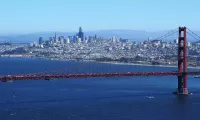
San Francisco is a major commercial financial and cultural hub...
National Public Radio NPR is an American public broadcasting organization...

A car also known as an automobile is a wheeled...
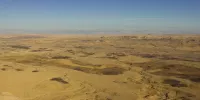
A desert is a landscape characterized by minimal precipitation leading...
Trending

2 months ago Laura Ingraham: A Prominent Voice in American Conservative Media
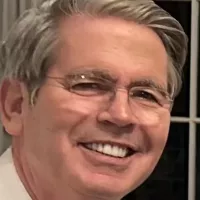
26 days ago Scott Bessent Predicts Oil Price Drop Contingent on Venezuelan Events; Gas Prices Impacted.

Andre Drummond is a Jamaican-American professional basketball player currently playing center for the Philadelphia ers in the NBA He was...
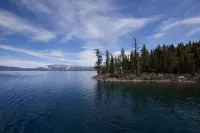
1 month ago Lake Tahoe: Service Roads Closure, Heavenly Village Ice Rink Opens with Bear!
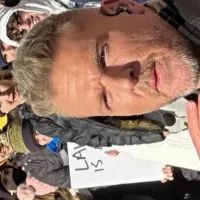
2 months ago Pat McAfee's Hilarious Halloween Costume: Cowher Reacts to 'Old Sports Media Man'
6 months ago Indian Regulator Bars Jane Street From Securities Market, Orders Disgorgement of ?4,844 Crore.
Popular

Candace Owens is an American conservative political commentator and author...
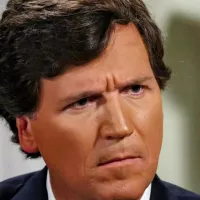
Tucker Carlson is an American conservative political commentator known for...

XXXTentacion born Jahseh Dwayne Ricardo Onfroy was a controversial yet...

Ilhan Omar is an American politician currently serving as the...

Kashyap Pramod Patel is an American lawyer who became the...

Bill Gates an American businessman and philanthropist revolutionized personal computing...
